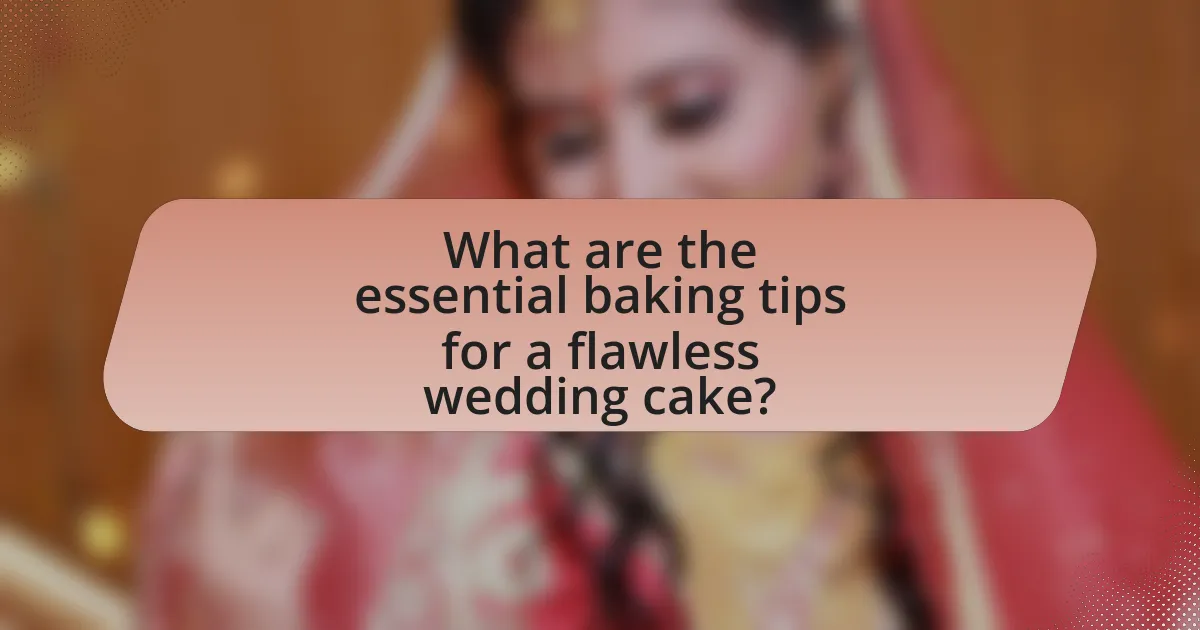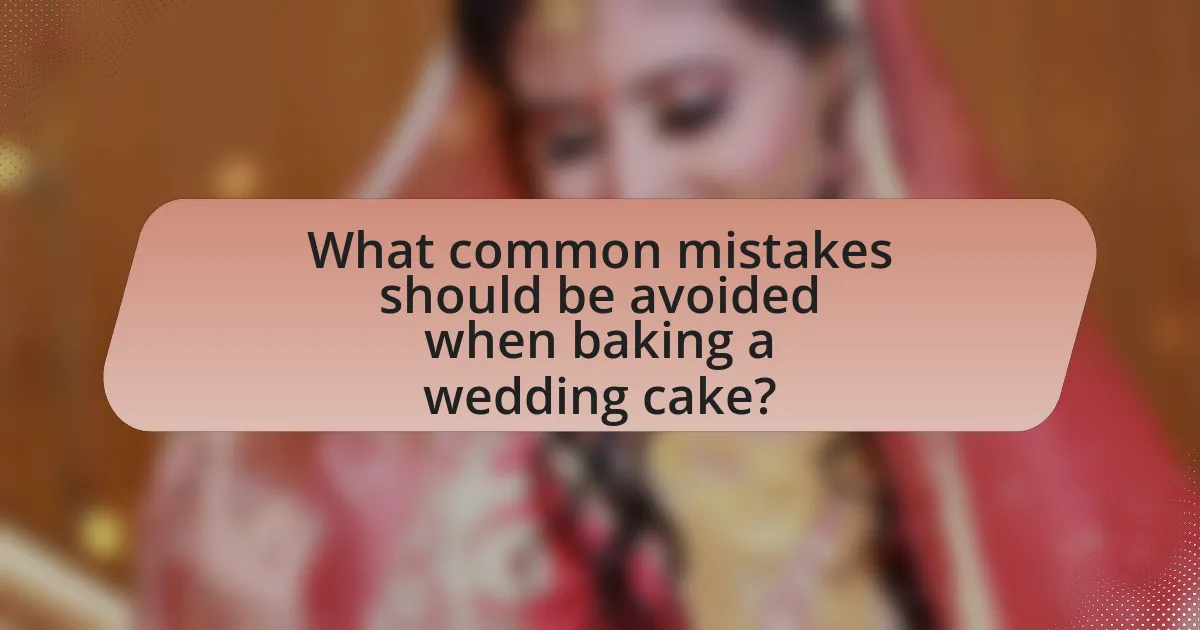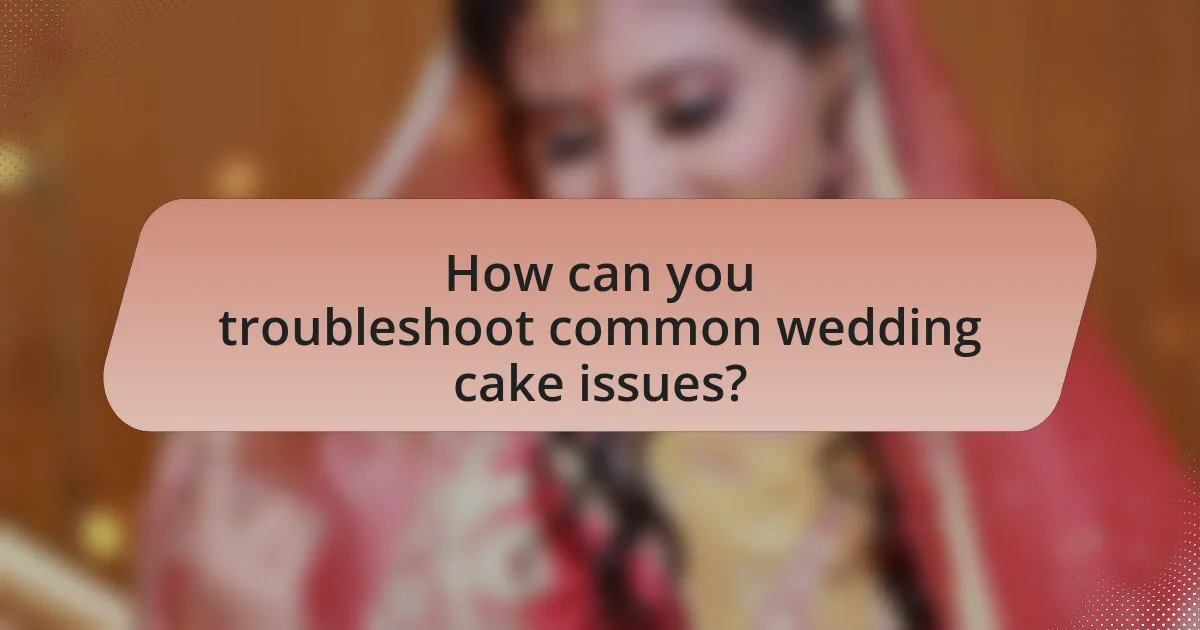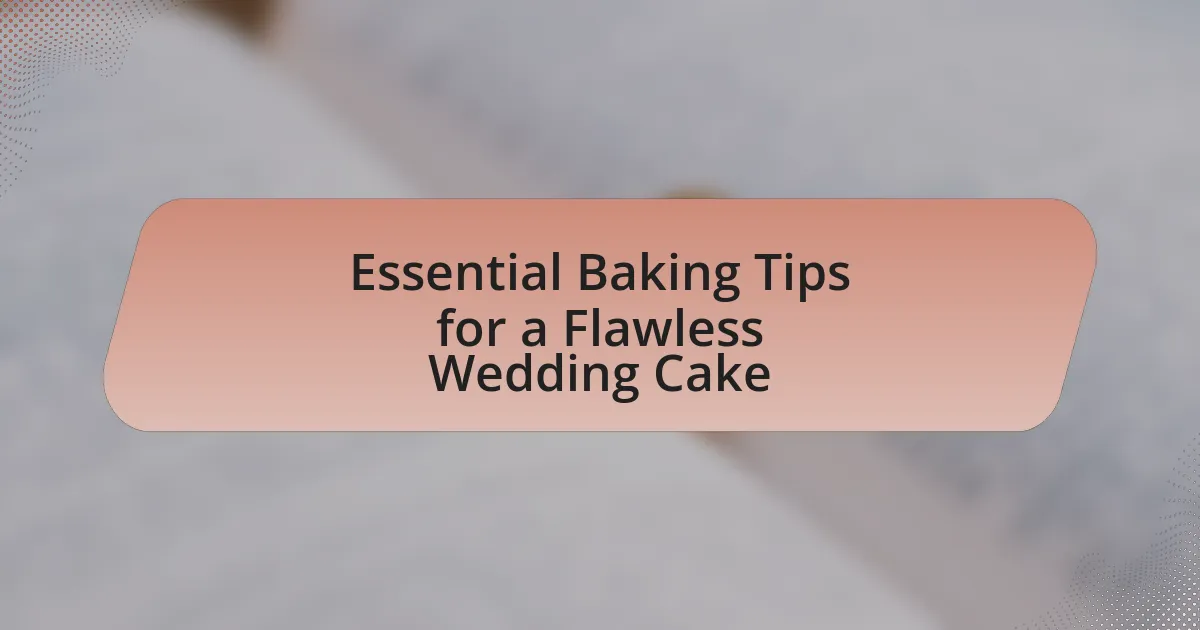The article provides essential baking tips for creating a flawless wedding cake, emphasizing the importance of high-quality ingredients, accurate measurements, and reliable recipes. Key topics include selecting the right types of flour and sugars, crucial baking techniques, and the significance of proper mixing and baking temperatures. Additionally, it addresses common pitfalls to avoid, such as overmixing and incorrect ingredient measurements, while offering solutions for troubleshooting issues like sinking or dryness. The article also highlights the importance of cake decoration and provides best practices for achieving a professional finish.

What are the essential baking tips for a flawless wedding cake?
To achieve a flawless wedding cake, it is essential to use high-quality ingredients, accurately measure them, and follow a reliable recipe. High-quality ingredients, such as fresh eggs, premium flour, and real butter, contribute to the cake’s flavor and texture. Accurate measurement ensures consistency; using a kitchen scale for dry ingredients and liquid measuring cups for wet ingredients is recommended. Following a reliable recipe, preferably one tested multiple times, minimizes the risk of errors. Additionally, proper mixing techniques, such as creaming butter and sugar until light and fluffy, help incorporate air for a lighter cake. Baking at the correct temperature, typically around 350°F (175°C), is crucial for even cooking. Finally, allowing the cake to cool completely before frosting prevents melting and ensures a smooth finish.
How do you choose the right ingredients for a wedding cake?
To choose the right ingredients for a wedding cake, prioritize high-quality, fresh components that align with the desired flavor profile and dietary preferences of the couple. Essential ingredients include flour, sugar, eggs, butter, and flavorings, with each playing a crucial role in texture and taste. For example, using cake flour instead of all-purpose flour results in a lighter, fluffier cake, while high-quality vanilla extract enhances flavor significantly. Additionally, consider incorporating seasonal fruits or unique flavorings to personalize the cake. Selecting organic or locally sourced ingredients can also improve taste and support sustainability.
What types of flour are best for wedding cakes?
The best types of flour for wedding cakes are cake flour and all-purpose flour. Cake flour, which has a lower protein content (around 7-9%), produces a tender and light texture ideal for delicate cakes. All-purpose flour, with a protein content of about 10-12%, can also be used, providing a slightly denser cake while still maintaining good structure. The choice between these flours depends on the desired texture; cake flour is preferred for a softer crumb, while all-purpose flour offers versatility for various cake styles.
How do different sugars affect the cake’s texture and flavor?
Different sugars significantly influence a cake’s texture and flavor. Granulated sugar creates a light and airy texture due to its ability to incorporate air during creaming, while brown sugar adds moisture and a denser texture because of its molasses content, which also imparts a rich, caramel-like flavor. Powdered sugar, with its fine texture, contributes to a smoother batter and can enhance sweetness without affecting the cake’s structure as much. Research indicates that the type of sugar used can alter the cake’s final moisture content and sweetness level, impacting overall flavor and mouthfeel.
What baking techniques are crucial for a perfect wedding cake?
The crucial baking techniques for a perfect wedding cake include precise measuring, proper mixing methods, and appropriate baking temperatures. Precise measuring ensures accurate ingredient ratios, which is essential for achieving the desired texture and flavor; for example, using a kitchen scale can improve consistency. Proper mixing methods, such as creaming butter and sugar until light and fluffy, incorporate air for leavening, which contributes to a light cake structure. Additionally, baking at the correct temperature, typically around 325°F to 350°F, allows for even cooking and prevents the cake from doming or burning. These techniques are validated by professional baking standards, which emphasize the importance of accuracy and technique in cake preparation.
How does proper mixing impact the cake’s rise and crumb?
Proper mixing is crucial for achieving the desired rise and crumb texture in a cake. When ingredients are mixed correctly, air is incorporated into the batter, which helps create a light and fluffy structure as the cake bakes. This aeration is essential for the leavening process, allowing the cake to rise properly.
Additionally, proper mixing ensures that the ingredients are evenly distributed, which contributes to a uniform crumb structure. Over-mixing can lead to a dense cake due to gluten development, while under-mixing may result in uneven texture and rise. Therefore, achieving the right balance in mixing is vital for a successful cake outcome.
What is the importance of accurate baking times and temperatures?
Accurate baking times and temperatures are crucial for achieving the desired texture and flavor in baked goods. When baking, precise measurements ensure that ingredients react correctly, leading to proper rising and even cooking. For instance, cakes baked at the correct temperature will rise adequately and maintain moisture, while incorrect temperatures can result in dense or dry outcomes. Research indicates that baking at the right temperature can affect the Maillard reaction, which is essential for flavor development, as noted in “The Science of Good Cooking” by Cook’s Illustrated. Therefore, following accurate baking times and temperatures is essential for creating a flawless wedding cake.
Why is cake decoration important for a wedding cake?
Cake decoration is important for a wedding cake because it enhances the visual appeal and reflects the couple’s personal style and theme of the wedding. A well-decorated cake serves as a focal point during the reception, contributing to the overall aesthetic and ambiance. According to a survey by The Knot, 78% of couples consider the cake’s design to be a significant aspect of their wedding planning, indicating its importance in creating memorable experiences.
What are the best frosting options for wedding cakes?
The best frosting options for wedding cakes include buttercream, cream cheese frosting, fondant, and ganache. Buttercream is popular for its smooth texture and versatility, allowing for various flavors and decorations. Cream cheese frosting offers a tangy flavor that pairs well with many cake types, particularly carrot and red velvet. Fondant provides a sleek, polished finish and is ideal for intricate designs, while ganache adds a rich chocolate flavor and can be used for both frosting and filling. These options are favored for their taste, aesthetic appeal, and ability to complement various cake flavors.
How can you achieve a professional finish in cake decoration?
To achieve a professional finish in cake decoration, ensure that the cake is properly leveled and chilled before applying any frosting or fondant. A leveled cake prevents uneven surfaces, while chilling helps the frosting set and makes it easier to work with. Use high-quality ingredients for both the cake and the decorations, as this enhances the overall appearance and taste. Additionally, employing techniques such as smooth frosting application, using a bench scraper for even edges, and practicing piping skills can significantly improve the finish. For instance, a study by the American Institute of Baking emphasizes that proper temperature control and ingredient quality are crucial for achieving a polished look in cake decoration.

What common mistakes should be avoided when baking a wedding cake?
Common mistakes to avoid when baking a wedding cake include not measuring ingredients accurately, which can lead to imbalanced flavors and textures. Additionally, failing to properly prepare the cake pans can result in sticking, making it difficult to remove the cakes without damage. Overmixing the batter can cause a dense cake, while undermixing can lead to uneven texture. Not allowing the cakes to cool completely before frosting can cause melting and sliding of the icing. Lastly, neglecting to test the cake for doneness can result in underbaked or overbaked layers, compromising the overall quality of the cake.
How can overmixing affect the wedding cake outcome?
Overmixing can lead to a dense and tough wedding cake. This occurs because excessive mixing develops gluten in the flour, which results in a firmer texture rather than the desired light and airy crumb. The ideal mixing time is crucial; typically, mixing should be just enough to combine ingredients without overworking the batter. Studies in baking science indicate that cakes mixed beyond the optimal point can lose their delicate structure, leading to a less enjoyable eating experience.
What signs indicate that a cake has been overmixed?
A cake has been overmixed if it exhibits a dense texture, a gummy or rubbery consistency, and a peaked top. Overmixing develops gluten excessively, which leads to these undesirable characteristics. Additionally, an overmixed cake may have a tough crumb and can result in a dry final product, as the air incorporated during mixing is lost. These signs are critical indicators that the mixing process has gone too far, negatively impacting the cake’s overall quality.
How can you prevent overmixing during preparation?
To prevent overmixing during preparation, mix ingredients just until they are combined. This approach minimizes gluten development, which can lead to a dense texture in baked goods. Using a gentle folding technique instead of vigorous stirring can also help maintain the desired lightness in the batter. Additionally, monitoring the mixing time and stopping as soon as no dry ingredients are visible ensures that the mixture remains airy and tender.
What are the pitfalls of incorrect ingredient measurements?
Incorrect ingredient measurements can lead to significant issues in baking, such as texture problems, flavor imbalances, and structural failures. For instance, using too much flour can result in a dense cake, while insufficient sugar may lead to a lack of sweetness and poor browning. Accurate measurements are crucial; a study published in the Journal of Food Science highlights that precise ingredient ratios directly affect the chemical reactions during baking, which in turn influences the final product’s quality. Therefore, incorrect measurements can compromise the overall success of a wedding cake, making it essential to adhere to exact quantities for optimal results.
How can inaccurate measurements alter the cake’s structure?
Inaccurate measurements can significantly alter a cake’s structure by affecting its density, texture, and rise. For instance, too much flour can lead to a dry and dense cake, while insufficient flour may cause the cake to collapse due to lack of support. Additionally, incorrect amounts of liquid can disrupt the batter’s consistency, impacting how well the cake rises during baking. Research indicates that precise ingredient ratios are crucial for achieving the desired chemical reactions, such as leavening, which directly influence the cake’s final structure.
What tools can help ensure precise measurements?
Digital kitchen scales are essential tools that help ensure precise measurements in baking. These scales provide accurate weight readings, allowing bakers to measure ingredients with precision, which is crucial for achieving consistent results in recipes. For example, a study published in the Journal of Food Science found that using weight measurements instead of volume can improve the accuracy of ingredient proportions, leading to better texture and flavor in baked goods. Additionally, measuring cups and spoons marked with clear measurements can also aid in achieving precise volume measurements, but digital scales are generally preferred for their accuracy.

How can you troubleshoot common wedding cake issues?
To troubleshoot common wedding cake issues, first identify the specific problem, such as a cake that is sinking, cracking, or not rising properly. For a sinking cake, ensure that the oven temperature is accurate and that the cake is not overmixed, as both can lead to collapse. If the cake is cracking, check that the oven temperature is not too high and that the cake is baked evenly. For cakes that do not rise, verify that the baking powder is fresh and that the ingredients are measured correctly. These troubleshooting steps are supported by baking science, which indicates that proper temperature control and ingredient balance are crucial for cake structure and stability.
What should you do if your cake sinks in the middle?
If your cake sinks in the middle, you should first check the baking time and temperature, as underbaking or baking at too low a temperature can cause sinking. Cakes require a specific baking time and temperature to set properly; for example, most cakes bake at 350°F for 25-35 minutes. If the cake has already sunk, you can try to salvage it by trimming the top to create a flat surface, which can then be covered with frosting or decorations. This approach is commonly used in professional baking to ensure a visually appealing final product despite initial baking issues.
What are the possible causes of a sinking cake?
A sinking cake can be caused by several factors, including underbaking, incorrect oven temperature, and excessive leavening agents. Underbaking occurs when the cake is removed from the oven before it has fully set, leading to collapse as it cools. An incorrect oven temperature, often due to an inaccurate thermostat, can cause the cake to rise too quickly and then sink. Excessive leavening agents, such as baking powder or baking soda, can create too much lift, resulting in a fragile structure that cannot support itself. These factors are well-documented in baking literature, emphasizing the importance of precise measurements and proper baking techniques to achieve a stable cake.
How can you fix a sunken cake before serving?
To fix a sunken cake before serving, you can level the top with a serrated knife and fill the depression with frosting or whipped cream. This method effectively disguises the sunken area and maintains the cake’s aesthetic appeal. The technique is commonly used in baking to correct imperfections, ensuring that the cake looks presentable for serving.
How can you prevent a dry wedding cake?
To prevent a dry wedding cake, ensure proper moisture retention by incorporating ingredients like sour cream or yogurt into the batter. These ingredients add moisture and fat, which help maintain a tender crumb. Additionally, avoid overbaking the cake, as this can lead to dryness; using a toothpick to check for doneness when the cake is just set in the center is crucial. According to baking experts, cakes should be removed from the oven when they are slightly underbaked, as they continue to cook from residual heat.
What factors contribute to a cake becoming dry?
A cake becomes dry primarily due to insufficient moisture, overbaking, and improper ingredient ratios. Insufficient moisture occurs when there is not enough liquid or fat in the batter, which can lead to a lack of tenderness. Overbaking happens when the cake is left in the oven for too long, causing excessive evaporation of moisture. Additionally, incorrect ingredient ratios, such as too much flour or not enough sugar, can disrupt the cake’s ability to retain moisture. These factors are supported by baking science, which indicates that the balance of ingredients and baking time directly affects the cake’s texture and moisture content.
How can you keep your wedding cake moist during storage?
To keep your wedding cake moist during storage, wrap it tightly in plastic wrap and store it in an airtight container. This method prevents air exposure, which can lead to drying out. Additionally, refrigerating the cake can help maintain its moisture, as cooler temperatures slow down the staling process. According to baking experts, cakes stored this way can retain their moisture for several days, ensuring they remain fresh and delicious for your special occasion.
What are the best practices for baking a wedding cake successfully?
The best practices for baking a wedding cake successfully include precise measurements, using high-quality ingredients, and allowing adequate baking time. Precise measurements ensure the correct balance of flavors and textures, while high-quality ingredients, such as fresh eggs and premium butter, enhance the cake’s taste and structure. Additionally, allowing the cake to bake for the recommended time prevents undercooking or overcooking, which can compromise the cake’s integrity. Following these practices leads to a wedding cake that is not only visually appealing but also delicious and structurally sound.
How can planning ahead improve your wedding cake baking process?
Planning ahead can significantly enhance the wedding cake baking process by allowing for better organization and time management. When bakers create a detailed timeline and checklist, they can ensure that all ingredients are prepared, tools are ready, and baking steps are executed in a timely manner. This proactive approach minimizes the risk of last-minute errors, such as forgetting essential ingredients or miscalculating baking times, which can lead to subpar results. Studies show that organized planning can reduce stress and improve overall outcomes in baking, as it allows for adjustments and troubleshooting before the actual baking begins.
What tips can help ensure a stress-free baking experience?
To ensure a stress-free baking experience, thorough preparation is essential. Start by gathering all ingredients and tools before beginning, as this minimizes interruptions and confusion during the baking process. Additionally, following a detailed recipe step-by-step helps maintain focus and reduces the likelihood of mistakes. Research shows that organized workspaces lead to increased efficiency and lower stress levels in cooking and baking (Journal of Culinary Science & Technology, 2017). Lastly, allowing ample time for baking and cooling prevents the rush that often leads to errors, ensuring a smoother overall experience.
